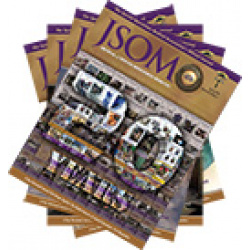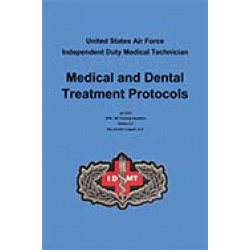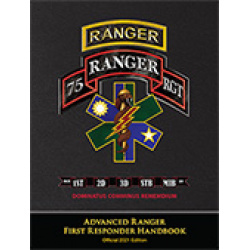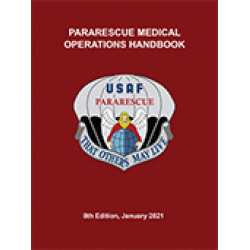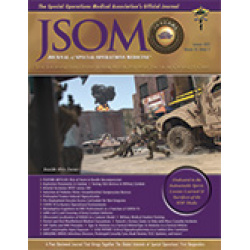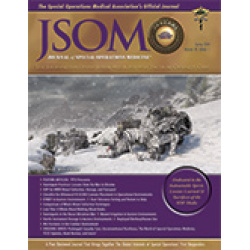Breakaway Media, LLC

Thousands of Americans wounded in combat died in Vietnam - when they could easily have been saved. More deaths than in the Twin Towers on 9/11. More deaths than Pearl Harbor. In 1990, there had been very little progress made in battlefield trauma care since the Civil War. But the revolutionary new concepts embodied in Tactical Combat Casualty Care (TCCC) have changed that landscape dramatically.
Against great odds, TCCC has reduced the incidence of preventable deaths among combat casualties to the lowest level in history and has been credited with saving the lives of thousands of our nation’s wounded Servicemembers in the recent conflicts in Iraq and Afghanistan. TCCC is now mandated by the U.S. Department of Defense as the nation’s standard for battlefield trauma care.
TCCC has forever changed the way care will be provided to America’s combat wounded and is now being used by militaries around the world and in civilian prehospital trauma care as well.
This is a medical book like no other because it is a combat medical story like no other.
For orders of 5 or more, click here to fill out the Request Form, and we will contact you with a quote.
Brown J, Soto MA, Lindsay KG, Harris M, Karagosian SA, Bailey K, Hutchins A 99(5). 0 (Journal Article)
Background: This study assessed omega-3 fatty acid (O3FA) status, previous brain injury risk exposures, and associations between O3FA status and risk exposures among active-duty military personnel. Methods: O3FA status was measured by a Holman omega-3 blood test. A survey was conducted to assess brain injury risk history and dietary O3FA factors. Results: More than 50% of the participants had high-risk status, based on an omega-3 index (O3I) <4%, while less than 2% of the participants recorded low-risk O3I (>8%). O3FA supplementation (p<.001, Cramer's V=0.342) and fish consumption (p<.001, Cramer's V=0.210) were positively correlated with O3FA status. Only 5 O3FA supplement users (n=97 [5.2%]) had a low-risk O3I status, while all nonusers (n=223) had moderateto high-risk O3I status. Conclusions: Supplementing with O3FA was associated with better O3I status in this population. However, only a few participants achieved optimal O3I status even when taking an O3FA supplement. Participants who ate fish and did not supplement were in the moderateor high-risk O3I groups.
Osborne K, Wenthe A, Mahowald M, Bridwell R 99(5). 0 (Case Reports)
Special Operations Servicemembers presenting with palpitations, pre-syncope, or exertional syncope during rigorous physical training are often experiencing a benign condition; however, life-threatening etiologies should be considered. We describe a 43-year-old Special Operator who presented to his medics during selection physical assessment testing with palpitations and lightheadedness, with a subsequent workup revealing arrhythmogenic right ventricular cardiomyopathy (ARVC). His initial electrocardiogram was unremarkable without characteristic ARVC changes. Outpatient evaluation with ambulatory cardiac monitoring recorded numerous episodes of non-sustained ventricular tachycardia. Transthoracic echocardiography demonstrated findings concerning for ARVC, with subsequent cardiac MRI confirming the diagnosis via the 2020 Padua criteria. Management includes activity modification, class III anti-arrhythmic medications, and possible placement of an implantable cardioverter defibrillator to prevent sudden cardiac death. This case demonstrates the importance of maintaining high clinical suspicion for rare diagnoses that present with exertional palpitations, such as arrhythmogenic right ventricular cardiomyopathy, in even our fittest Special Operators.
Blakeman T, Smith M, Branson R 99(5). 0 (Journal Article)
Introduction: Maximizing the capabilities of available lowflow oxygen is key to providing adequate oxygen to prevent/treat hypoxemia and conserve oxygen. We designed a closed-circuit system that allows rebreathing of gases while scrubbing carbon dioxide (CO2) in conjunction with portable mechanical ventilators in a bench model. Methods: We evaluated the system using two portable mechanical ventilators currently deployed by the Department of Defense-Zoll 731 and AutoMedx SAVe II-over a range of ventilator settings and lung models, using 1 and 3L/min low-flow oxygen into a reservoir bag. We measured peak inspired oxygen concentration (FiO2), CO2-absorbent life, gas temperature and humidity, and the effect of airway suctioning and ventilator disconnection on FiO2 on ground and at altitude. Results: FiO2 was ≥0.9 across all ventilator settings and altitudes using both oxygen flows. CO2-absorbent life was >7 hours. Airway humidity range was 87%-97%. Mean airway temperature was 25.4°C (SD 0.5°C). Ten-second suctioning reduced FiO2 22%-48%. Thirtysecond ventilator disconnect reduced FiO2 29%-63% depending on oxygen flow used. Conclusion: Use of a rebreathing system with mechanical ventilation has the potential for oxygen conservation but requires diligent monitoring of inspired FiO2 and CO2 to avoid negative consequences.
Inman BL, Long B, April MD, Fisher AD, Rizzo J, Schauer S 99(5). 0 (Journal Article)
Background: The development of acute traumatic coagulopathy is associated with increased mortality and morbidity in patients with battlefield traumatic injuries. Currently, the incidence of acute traumatic coagulopathy in the Role 1 setting is unclear. Methods: We queried the Prehospital Trauma Registry (PHTR) module of the Department of Defense Trauma Registry (DoDTR) for all encounters from inception through May 2019. The PHTR captures data on Role 1 prehospital care. Data from the PHTR was linked to the DoDTR to analyze laboratory data and patient outcomes using descriptive statistics. We defined coagulopathy as an international normalized ratio (INR) of ≥1.5 or platelet count ≤150×109/L. Results: A total of 595 patients met the inclusion criteria; 36% (212) met our definition for coagulopathy, with 31% (185) carrying low platelet numbers, 11% (68) showing an elevated INR, and 7% (41) with both. The baseline (no coagulopathy) cohort had a mean INR of 1.10 (95% CI 1.09-1.12) versus 1.38 (95% CI 1.33-1.43) in the coagulopathic cohort. The mean platelet count was 218 (95% CI 213-223) ×109/L in the baseline cohort versus 117 (95% CI 110-125) ×109/L in the coagulopathic cohort. Conclusions: Our findings indicate a high incidence of coagulopathy in trauma patients. Approximately one-third of wounded patients had laboratory evidence of coagulopathy upon presentation to a forward medical care facility. Advanced diagnostic facilities are therefore needed to facilitate early diagnosis of acute traumatic coagulopathy. Blood products with a long shelf life can aid in early correction.
Wagner C, Davis G, Donato M, Bedard P, Bridwell R 99(5). 0 (Case Reports)
Lumbar paraspinal muscle compartment syndrome is an uncommon, rapidly progressive, and potentially devastating injury with fewer than 40 cases reported in the literature. It initially mimics nonemergent causes of low back pain, disproportionately affects young men, and is most often secondary to acute physical exertion. The disease process is commonly associated with rhabdomyolysis. Diagnostic tools include physical examination, measurement of lactate and creatine kinase levels, MRI, and direct compartment pressure measurement. While medical and nonoperative management strategies have been explored, the gold standard for treatment is emergent lumbar fasciotomy. Opioid and non-steroidal pain management, as well as physical therapy, are the mainstays of post-treatment recovery, with many surgical patients reporting complete symptom resolution at long-term follow-up. This article discusses the case of a 27-year-old, male, active-duty, Special Operations Aviation Soldier who presented to the emergency department and was found to have lumbar paraspinal muscle compartment syndrome.
The 20th Anniversary Collector's Edition features all 4 editions of the 2020 Journal of Special Operations Medicine. Each edition features a retrospective look at the evolution of SOF Medicine and TCCC protocols.
The Spring edition focuses on the use of whole blood, Summer deals with Hemorrhage Control, Fall looks at Prolonged Field Care, and Winter dives into the changes to TCCC.
Regular price for all 4 journals is $160 - buy the set for $128 - a 20% savings!
Davis K, Oury JJ, Reed BL, Grabo DJ, Wilson A, Coleman C 99(5). 0 (Journal Article)
Needle decompression is a mainstay intervention for tension pneumothorax in trauma medicine. It is used in combat and prehospital medicine when definitive measures are often not available or ideal. It can temporarily relieve increased intrathoracic pressure and treat a collapsed lung or great vessel obstruction. However, when done incorrectly, it can result in underlying visceral organ and vessel trauma. This is a case of an adult male who presented to the emergency department after sustaining multiple stab wounds during an altercation. On arrival, the patient had a 14-gauge angiocatheter inserted at the 4th intercostal space (ICS), left of the parasternal line traversing the right ventricle and interventricular septum and terminating in the left ventricle. The case emphasizes the importance of understanding the landmarks of performing needle decompression in increasing the procedure's efficacy and reducing iatrogenic complications.
Lalli K, Charkoudian N, Moreh Y, Degroot D 99(5). 0 (Journal Article)
Exertional heat stroke (EHS) is a medical emergency characterized by elevated body temperature and central nervous system dysfunction, and it can include dizziness, confusion and loss of consciousness, as well as long-term organ and tissue damage. EHS is distinct from classic, or passive, heat stroke and is most commonly observed during intense physical activity in warfighters, athletes, and laborers. EHS is an ongoing non-combat threat that represents a risk to both the health and readiness of military personnel. Potential risk factors and their mitigation have been the subject of investigation for decades. One risk factor that is often mentioned in the literature, but not well quantified, is that of individual motivation to excel, wherein highly trained military personnel and athletes exert themselves beyond their physiological limits because of a desire to complete tasks and goals. The motivation to excel in tasks with high standards of achievement, such as those within elite military schools, appears to create an environment in which a disproportionately high number of exertional heat illness casualties occur. Here, we review existing biomedical literature to provide information about EHS in the context of motivation as a risk factor and then discuss five cases of EHS treated at Martin Army Community Hospital at Fort Moore, GA, from 2020 to 2022. In our discussion of the cases, we explore the influence of motivation on each occurrence. The findings from this case series provide further evidence of motivation to excel as a risk factor for EHS and highlight the need for creative strategies to mitigate this risk.
Leone R, Remondelli MH, Smith SS, Moore BJ, Wuss SL, D'Angelo M 99(5). 0 (Editorial)
Knapp JG, Tang N 99(5). 0 (Journal Article)
Separate evidence-based, best practice guidelines and recommendations exist for the prehospital management of traumatic injuries sustained in combat settings and those encountered during high-threat civilian operational incidents. The Bureau of Alcohol, Tobacco, Firearms and Explosives (ATF) Tactical Medic Program is a mature operational medicine asset supporting high-threat federal law enforcement operations. The ATF conducted an audit of its agency-issued tactical medic bags with regards to completeness, as defined by authorized medical protocols, which are aligned with current Tactical Combat Casualty Care and Tactical Emergency Casualty Care guidelines.
This current set of medical guidelines was developed by collaborating with Emergency Medicine professionals, experienced Flight Medics, Aeromedical Physician Assistants, Critical Care Nurses, and Flight Surgeons. There has been close coordination in developing these guidelines by the Joint Trauma System, the Committee of En Route Combat Casualty Care, and the Committee of Tactical Combat Casualty Care. The shared goal is to ensure excellent en-route care that is standard across all evacuation and emergency medical pre-hospital units. All these enhancements and improvements will advance en-route care across the services and the Department of Defense. This handbook was published in February 2024.
For orders of 5 or more, click here to fill out the Request Form, and we will contact you with a quote.
Digital Flipbook and PDF versions of this handbook are available as a subscription to the JSOM. You can subscribe here.
US Air Force Independent Duty Medical Technician (IDMT), Medical and Dental Treatment Protocols, Ed 2.3 Handbook published in January 2021 is a resource for Air Force IDMT medical personnel with advanced skills and knowledge. These protocols are the product of a concerted effort by representatives from all major command surgeons' offices with the express goal to standardize the care IDMTs are permitted to provide regardless of location and command affiliation. These protocols clearly define the scope of care parameters that the IDMT is expected and trained to work within. These treatment protocols are designed as a guide to accepted step-by-step treatments for medical disorders that may be encountered by IDMTs in the field.
For orders of 5 or more, click here to fill out the Request Form, and we will contact you with a quote.
Digital Flipbook and PDF versions of this handbook are available as a subscription to the JSOM. You can subscribe here.
Table of Contents
For orders of 5 or more, click here to fill out the Request Form, and we will contact you with a quote.
Digital Flipbook and PDF versions of this handbook are available as a subscription to the JSOM. You can subscribe here.
View the Table of Contents
Customers living in Europe can purchase the Advanced Ranger First Responder Handbook 2021 Updates through WERO GmbH and save a significant amount of money on shipping and processing. The ARFR can be purchased at this link.
Before you buy, you will receive an offer with your total price, including shipping and VAT.
Kunden mit Wohnsitz in Europa können die Advanced Ranger First Responder Handbook 2021 Updates über die WERO GmbH erwerben und dabei erheblich an Versand- und Bearbeitungskosten sparen. Die ARFR kann unter diesem Link erworben werden.
Vor dem Kauf erhalten Sie ein Angebot mit Ihrem Gesamtpreis, inklusive Versand und Mehrwertsteuer.
This revised handbook includes an outline of the principles of PJ medicine and the patient assessment checklist. This approach to patients is slightly modified from traditional primary and secondary surveys to reflect a more efficient and comprehensive approach to combat trauma based on PJ experience and data from Overseas Contingency Operations.
This handbook includes portions of the Tactical Combat Casualty Care (TCCC) guidelines and the ATP Tactical Medical Emergency Protocols (TMEPS) pertaining to Pararescue. These protocols have are to suit the PJ mission. The goal remains to have all PJs work to a single standard. The section on prolonged care has been modified and expanded based on PJ experiences.
For orders of 5 or more, click here to fill out the Request Form, and we will contact you with a quote.
Digital Flipbook and PDF versions of this handbook are available as a subscription to the JSOM. You can subscribe here.
View the Table of Contents.
This version of the PJ Handbook is printed on waterproof, tearproof paper and is spiral bound with a 1/2" ring.
For orders of 5 or more, click here to fill out the Request Form, and we will contact you with a quote.
Digital Flipbook and PDF versions of this handbook are available as a subscription to the JSOM. You can subscribe here.
View the Table of Contents
Print: 978-1-7366242-3-4
Customers living in Europe can purchase the Ranger Medic Handbook 2022 Updates through WERO GmbH and save significant money on shipping and processing. The RMH can be purchased at this link.
Before you buy, you will receive an offer with your total price, including shipping and VAT.
Kunden, die in Europa leben, können die Ranger Medic Handbook 2022 Updates über die WERO GmbH erwerben und dabei erheblich an Versand- und Bearbeitungskosten sparen. Das RMH kann unter diesem Link erworben werden.
Vor dem Kauf erhalten Sie ein Angebot mit Ihrem Gesamtpreis, inklusive Versand und Mehrwertsteuer.
The Advanced Tactical Protocols-Paramedic (ATP-P) Handbook is an essential reference tool for tactical and combat medics, SWAT team members, and medical professionals operating in austere environments.
This handbook is printed on waterproof/tearproof paper. Please note: Do not expose this product to chemicals such as cleaning supplies, lotions, etc., as your book will be damaged.
This revision contains updates to the Airway Management protocols, Respiration / Breathing in Tactical Field Care, and K9 TCCC protocols.
Digital Flipbook and PDF versions of this handbook are available as a subscription to the JSOM. You can subscribe here.
The Advanced Tactical Protocols-Paramedic (ATP-P) Handbook is an essential reference tool for tactical and combat medics, SWAT team members, and medical professionals operating in austere environments.
This handbook is printed on standard paper and is NOT waterproof or tearproof.
This handbook is printed on the same standard paper as the ATP-10th edition. We also offer this handbook in waterproof/tearproof paper.
For orders of 5 or more, click here to fill out the Request Form, and we will contact you with a quote.
Digital Flipbook and PDF versions of this handbook are available as a subscription to the JSOM. You can subscribe here.
Brandt M, Liccardi C, Heidle J, Woods TD, White C, Mullins JR, Blackwell J, Le L, Brantley K 23(2). 44 (Journal Article)
Background: Recent data published by the Special Operations community suggest the Lethal Triad of Trauma should be changed to the Lethal Diamond, to include coagulopathy, acidosis, hypothermia, and hypocalcemia. The purpose of this study is to determine the prevalence of trauma-induced hypocalcemia in level I and II trauma patients. Methods: This is a retrospective cohort study conducted at a level I trauma center and Special Operations Combat Medic (SOCM) training site. Adult patients were identified via trauma services registry from September 2021 to April 2022. Patients who received blood products prior to emergency department (ED) arrival were excluded from the study. Ionized calcium levels were utilized in this study. Results: Of the 408 patients screened, 370 were included in the final analysis of this cohort. Hypocalcemia was noted in 189 (51%) patients, with severe hypocalcemia identified in two (<1%) patients. Thirty-two (11.2%) patients had elevated international normalized ratio (INR), 34 (23%) patients had pH <7.36, 21 (8%) patients had elevated lactic acid, and 9 (2.5%) patients had a temperature of <35°C. Conclusion: Hypocalcemia was prevalent in half of the trauma patients in this cohort. The administration of a calcium supplement empirically in trauma patients from the prehospital environment and prior to blood transfusion is not recommended until further data prove it beneficial.
Powell E, Betzold R, Kundi R, Anderson D, Haase D, Keville M, Galvagno S 24(1). 32 (Journal Article)
Background: Veno-venous extracorporeal membrane oxygenation (VV ECMO) is a low-frequency, high-intensity procedure used for severe lung illness or injury to facilitate rapid correction of hypoxemia and respiratory acidosis. This technology is more portable and extracorporeal support is more frequently performed outside of the hospital. Future conflicts may require prolonged causality care and more specialized critical care capabilities including VV ECMO to improve patient outcomes. We used an expert consensus survey based on a developed bifemoral VV ECMO cannulation checklist with an operational focus to establish a standard for training, validation testing, and sustainment. Methods: A 36-item procedural checklist was provided to 14 experts from multiple specialties. Using the modified Delphi method, the checklist was serially modified based on expert feedback. Results: Three rounds of the study were performed, resulting in a final 32-item checklist. Each item on the checklist received at least 70% expert agreement on its inclusion in the final checklist. Conclusion: A procedural performance checklist was created for bifemoral VV ECMO using the modified Delphi method. This is an objective tool to assist procedural training and validation for medical providers performing VV ECMO in austere environments.


 Español
Español 


